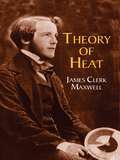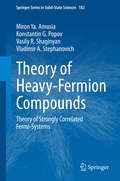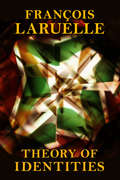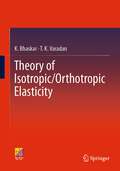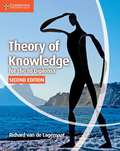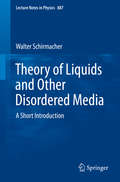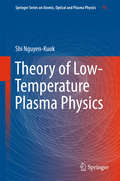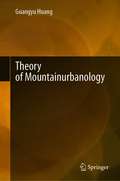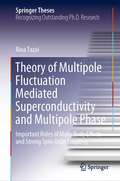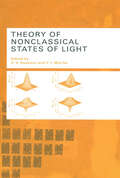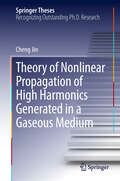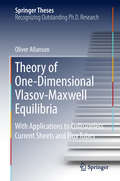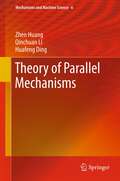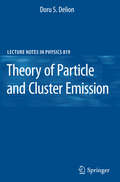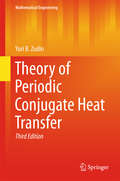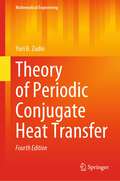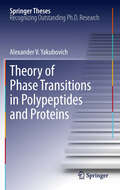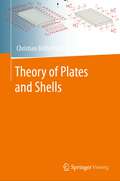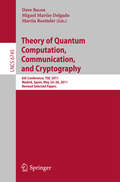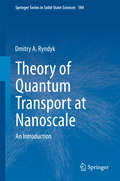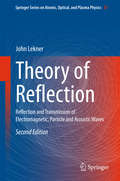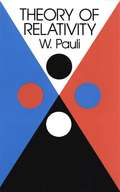- Table View
- List View
Theory of Heat (Dover Books on Physics)
by James Clerk MaxwellThough James Clerk Maxwell (1831–1879) is best remembered for his epochal achievements in electricity and magnetism, he was wide-ranging in his scientific investigations, and he came to brilliant conclusions in virtually all of them. As James R. Newman put it, Maxwell "combined a profound physical intuition, an exquisite feeling for the relationship of objects, with a formidable mathematical capacity to establish orderly connections among diverse phenomena. This blending of the concrete and the abstract was the chief characteristic of almost all his researches."Maxwell's work on heat and statistical physics has long been recognized as vitally important, but Theory of Heat, his own masterful presentation of his ideas, remained out of print for years before being brought back in this new edition. In this unjustly neglected classic, Maxwell sets forth the fundamentals of thermodynamics clearly and simply enough to be understood by a beginning student, yet with enough subtlety and depth of thought to appeal also to more advanced readers. He goes on to elucidate the fundamental ideas of kinetic theory, and — through the mental experiment of "Maxwell's demon" — points out how the Second Law of Thermodynamics relies on statistics.A new Introduction and notes by Peter Pesic put Maxwell's work into context and show how it relates to the quantum ideas that emerged a few years later. Theory of Heat will serve beginners as a sound introduction to thermal physics; advanced students of physics and the history of science will find Maxwell's ideas stimulating, and will be delighted to discover this inexpensive reprint of a long-unavailable classic.
Theory of Heavy-Fermion Compounds
by Vladimir A. Stephanovich Miron Ya. Amusia Konstantin G. Popov Vasily R. ShaginyanThis book explains modern and interesting physics in heavy-fermion (HF) compounds to graduate students and researchers in condensed matter physics. It presents a theory of heavy-fermion (HF) compounds such as HF metals, quantum spin liquids, quasicrystals and two-dimensional Fermi systems. The basic low-temperature properties and the scaling behavior of the compounds are described within the framework of the theory of fermion condensation quantum phase transition (FCQPT). Upon reading the book, the reader finds that HF compounds with quite different microscopic nature exhibit the same non-Fermi liquid behavior, while the data collected on very different HF systems have a universal scaling behavior, and these compounds are unexpectedly uniform despite their diversity. For the reader's convenience, the analysis of compounds is carried out in the context of salient experimental results. The numerous calculations of the non-Fermi liquid behavior, thermodynamic, relaxation and transport properties, being in good agreement with experimental facts, offer the reader solid grounds to learn the theory's applications. Finally, the reader will learn that FCQPT develops unexpectedly simple, yet completely good description of HF compounds.
Theory of Identities
by François LaruelleFrançois Laruelle proposes a theory of identity rooted in scientific notions of symmetry and chaos, emancipating thought from the philosophical paradigm of Being and reconnecting it with the real world. Unlike most contemporary philosophers, Laruelle does not believe language, history, and the world shape identity but that identity determines our relation to these phenomena. Both critical and constructivist, Theory of Identities finds fault with contemporary philosophy's reductive relation to science and its attachment to notions of singularity, difference, and multiplicity, which extends this crude approach. Laruelle's new theory of science, its objects, and philosophy, introduces an original vocabulary to elaborate the concepts of determination, fractality, and artificial philosophy, among other ideas, grounded in an understanding of the renewal of identity. Laruelle's work repairs the rift between philosophical and scientific inquiry and rehabilitates the concept of identity that continental philosophers have widely criticized. His argument positions him clearly against Deleuze, Badiou, the new materialists, and other thinkers who stray too far from empirical approaches that might revitalize philosophy's practical applications.
Theory of Inelastic Scattering and Absorption of X-rays
by Michel Van VeenendaalThis comprehensive, self-contained guide to X-ray spectroscopy will equip you with everything you need to begin extracting the maximum amount of information available from X-ray spectra. Key topics such as the interaction between X-rays and matter, the basic theory of spectroscopy, and selection and sum rules, are introduced from the ground up, providing a solid theoretical grounding. The book also introduces core underlying concepts such as atomic structure, solid-state effects, the fundamentals of tensor algebra and group theory, many-body interactions, scattering theory, and response functions, placing spectroscopy within a broader conceptual framework, and encouraging a deep understanding of this essential theoretical background. Suitable for graduate students, researchers, materials scientists and optical engineers, this is the definitive guide to the theory behind this powerful and widely used technique.
Theory of Isotropic/Orthotropic Elasticity
by K. Bhaskar T. K. VaradanThis book provides a lucid introduction to the theory of elasticity as applied to isotropic, specially orthotropic and laminated structures. With an application-oriented approach, the contents emphasize the need for rigorous analysis and illustrate its utility for a variety of problems. The simultaneous treatment of comparable isotropic and orthotropic problems enables one to easily visualize the changes in structural behaviour due to material orthotropy. Though intended as a textbook for graduate engineering study, this book is valuable as a self-study aid for practicing engineers as well.
Theory of Knowledge for the IB Diploma Second Edition
by Richard Van de LagemaatWritten by experienced practitioners this resource for Theory of Knowledge for the IB Diploma offers comprehensive coverage of and support for the new subject guide. This edition of Theory of Knowledge for the IB Diploma is fully revised for first examination in September 2015. The coursebook is a comprehensive, original and accessible approach to Theory of Knowledge, which covers all aspects of the revised subject guide. A fresh design ensures the content is accessible and user friendly and there is detailed guidance on how to approach the TOK essay and presentation. This edition supports the stronger emphasis on the distinction between personal and shared knowledge and the new areas of knowledge: religion and indigenous knowledge.
Theory of Liquids and Other Disordered Media
by Walter SchirmacherThis set of lectures provides an introduction to the structure, thermodynamics and dynamics of liquids, binary solutions and polymers at a level that will enable graduate students and non-specialist researchers to understand more specialized literature and to possibly start their own work in this field. Part I starts with the introduction of distribution functions, which describe the statistical arrangements of atoms or molecules in a simple liquid. The main concepts involve mean field theories like the Perkus-Yevick theory and the random phase approximation, which relate the forces to the distribution functions. In order to provide a concise, self-contained text, an understanding of the general statistical mechanics of an interacting many-body system is assumed. The fact that in a classic liquid the static and dynamic aspects of such a system can be discussed separately forms the basis of the two-fold structure of this approach. In order to allow polymer melts and solutions to be discussed, a short chapter acquaints readers with scaling concepts by discussing random walks and fractals. Part II of the lecture series is essentially devoted to the presentation of the dynamics of simple and complex liquids in terms of the generalized hydrodynamics concept, such as that introduced by Mori and Zwanzig. A special topic is a comprehensive introduction of the liquid-glass transition and its discussion in terms of a mode-coupling theory.
Theory of Low-Temperature Plasma Physics
by Shi Nguyen-KuokThis book offers the reader an overview of the basic approaches to the theoretical description of low-temperature plasmas, covering numerical methods, mathematical models and modeling techniques. The main methods of calculating the cross sections of plasma particle interaction and the solution of the kinetic Boltzmann equation for determining the transport coefficients of the plasma are also presented. The results of calculations of thermodynamic properties, transport coefficients, the equilibrium particle-interaction cross sections and two-temperature plasmas are also discussed. Later chapters consider applications, and the results of simulation and calculation of plasma parameters in induction and arc plasma torches are presented. The complex physical processes in high-frequency plasmas and arc plasmas, the internal and external parameters of plasma torches, near-electrode processes, heat transfer, the flow of solid particles in plasmas and other phenomena are considered. The book is intended for professionals involved in the theoretical study of low-temperature plasmas and the design of plasma torches, and will be useful for advanced students in related areas.
Theory of Mountainurbanology
by Guangyu HuangThis book is about mountainurbanology grounded in Southwest China, where mountain is a typical landform for many towns and cities. From the multi-disciplinary perspective in a dynamic changing context, it presents a comprehensive framework including the location of mountain city, planning, design, building, transportation, disaster, aesthetics and governance in building up mountain cities based on investigation of natural, social and economic studies. The book also emphasizes ecological planning method based on topography in mountainous area through the lens of teaching and practice on urban planning for over half a century in Southwest China. It is a highly informative book providing academic insight for senior undergraduates, graduate students, lecturers, research professionals and decision makers with an interest in urban planning, ecology, planning and design in mountainous region development. Prof. Guangyu Huang is regarded as Founding Pioneer of mountainurbanology in China, a sub-discipline of urban planning.
Theory of Multipole Fluctuation Mediated Superconductivity and Multipole Phase: Important Roles of Many Body Effects and Strong Spin-Orbit Coupling (Springer Theses)
by Rina TazaiA strong spin-orbit interaction and Coulomb repulsion featuring strongly correlated d- and f-electron systems lead to various exotic phase transition including unconventional superconductivity and magnetic multipole order. However, their microscopic origins are long standing problem since they could not be explained based on conventional Migdal-Eliashberg theorem. The book focuses on many-body correlation effects beyond conventional theory for the d- and f-electron systems, and theoretically demonstrates the correlations to play significant roles in “mode-coupling” among multiple quantum fluctuations, which is called U-VC here. The following key findings are described in-depth: (i) spin triplet superconductivity caused by U-VC, (ii) being more important U-VC in f-electron systems due to magnetic multipole degrees of freedom induced by a spin-orbit interaction, and (iii) s-wave superconductivity stabilized cooperatively by antiferromagnetic fluctuations and electron-phonon interaction contrary to conventional understanding. The book provides meaningful step for revealing essential roles of many-body effects behind long standing problems in strongly correlated materials.
Theory of Nonclassical States of Light
by V. V. Dodonov V. I. Man’koThe term 'nonclassical states' refers to the quantum states that cannot be produced in the usual sources of light, such as lasers or lamps, rather than those requiring more sophisticated apparatus for their production. Theory of Non-classical States of Light describes the current status of the theory of nonclassical states of light including many n
Theory of Nonlinear Propagation of High Harmonics Generated in a Gaseous Medium
by Cheng JinTheory of Nonlinear Propagation of High Harmonics Generated in a Gaseous Medium establishes the theoretical tools to study High-Order Harmonic Generation (HHG) by intense ultrafast infrared lasers in atoms and molecules. The macroscopic propagation of both laser and high-harmonic fields is taken into account by solving Maxwell's wave equations, while the single-atom or single-molecule response is treated with a quantitative rescattering theory by solving the time-dependent Schrödinger equation. This book demonstrates for the first time that observed experimental HHG spectra of atoms and molecules can be accurately reproduced theoretically when precise experimental conditions are known. The macroscopic HHG can be expressed as a product of a macroscopic wave packet and a photorecombination cross section, where the former depends on laser and experimental conditions while the latter is the property of target atoms or molecules. The factorization makes it possible to retrieve microscopically atomic or molecular structure information from the measured macroscopic HHG spectra. This book also investigates other important issues about HHG, such as contributions from multiple molecular orbitals, the minimum in the HHG spectrum, the spatial mode of laser beams, and the generation of an isolated attosecond pulse. Additionally, this book presents the photoelectron angular distribution of aligned molecules ionized by the HHG light.
Theory of One-Dimensional Vlasov-Maxwell Equilibria: With Applications To Collisionless Current Sheets And Flux Tubes (Springer Theses)
by Oliver AllansonThis book describes and contextualises collisionless plasma theory, and in particular collisionless plasma equilibria. The Vlasov–Maxwell theory of collisionless plasmas is an increasingly important tool for modern plasma physics research: our ability to sustain plasma in a steady-state, and to mitigate instabilities, determines the success of thermonuclear fusion power plants on Earth; and our understanding of plasma aids in the prediction and mitigation of Space Weather effects on terrestrial environments and satellites. Further afield, magnetic reconnection is a ubiquitous energy release mechanism throughout the Universe, and modern satellites are now able to make in-situ measurements with kinetic scale resolution. To keep pace with these challenges and technological developments, a modern scientific discussion of plasma physics must enhance, and exploit, its ‘literacy’ in kinetic theory. For example, accurate analytical calculations and computer simulations of kinetic instabilities are predicated on a knowledge of Vlasov–Maxwell equilibria as an initial condition. This book highlights new fundamental work on Vlasov–Maxwell equilibria, of potential interest to mathematicians and physicists alike. Possible applications involve two of the most significant magnetic structures known to confine plasma and store energy: current sheets and flux tubes.
Theory of Parallel Mechanisms
by Huafeng Ding Qinchuan Li Zhen HuangThis book contains mechanism analysis and synthesis. In mechanism analysis, a mobility methodology is first systematically presented. This methodology, based on the author's screw theory, proposed in 1997, of which the generality and validity was only proved recently, is a very complex issue, researched by various scientists over the last 150 years. The principle of kinematic influence coefficient and its latest developments are described. This principle is suitable for kinematic analysis of various 6-DOF and lower-mobility parallel manipulators. The singularities are classified by a new point of view, and progress in position-singularity and orientation-singularity is stated. In addition, the concept of over-determinate input is proposed and a new method of force analysis based on screw theory is presented. In mechanism synthesis, the synthesis for spatial parallel mechanisms is discussed, and the synthesis method of difficult 4-DOF and 5-DOF symmetric mechanisms, which was first put forward by the author in 2002, is introduced in detail. Besides, the three-order screw system and its space distribution of the kinematic screws for infinite possible motions of lower mobility mechanisms are both analyzed.
Theory of Particle and Cluster Emission
by Doru S. DelionNowadays experimental nuclear physics pushes its limits towards highly unstable nuclei. The theoretical description of proton-rich and neutronrich nuclei or superheavy elements has become an important part of the modern nuclear physics. The main tool to investigate such unstable nuclei concerns radioactive decays, from proton emission to fission processes. We review the main theoretical methods describing decay processes induced by the strong interaction, like Coupled channels method for Gamow resonances, R-matrix theory, Distorted wave approach, Semiclassical approach, Multi step and Two center shell model. Thus, most of the book is addressed to a broad audience within the nuclear physics community. Secondly, this book is an attempt to clarify some fundamental aspects connected with the fine structure or anisotropy in alpha decay and ternary cold fission. Finally, the self consistent microscopic theory of the alpha decay is analyzed.
Theory of Periodic Conjugate Heat Transfer
by Yuri B. ZudinThis book provides a detailed yet comprehensive presentation of the theory of periodic conjugate heat transfer. It contains an analytical approach to the effects of thermophysical and geometrical properties of a solid body on the experimentally determined heat transfer coefficient. The main objective of the book is a simplified description of the interaction between a solid body and a fluid as a boundary value problem of the heat conduction equation. This third and extended edition covers Wall's thermal effect on Landau stability, gas bubbles pulsations in fluids, and also the interplay between periodic conjugate heat transfer and non-Fourier heat conduction. The target audience primarily comprises research experts in the field of thermodynamics and fluid dynamics, but the book may also be beneficial for graduate students in engineering.
Theory of Periodic Conjugate Heat Transfer (Mathematical Engineering)
by Yuri B. ZudinAn original method of investigation of the conjugate conductive-convective problem of periodic heat transfer is developed. The novelty of the approach is that a particular conjugate problem is replaced by a general boundary-value problem for the heat conduction equation in the solid. Within the framework of the hyperbolic model of thermal conductivity, the effect of self-reinforcement of the degree of conjugation by increasing the period of oscillations is found. The processes of hydrodynamics and heat exchange with periodic internal structure are considered: periodic model of turbulent heat transfer, hydrodynamic instability, bubbles dynamics in liquid, and model of evaporating meniscus. The book is intended as a source and reference work for researchers and graduate students interested in the field of conjugate heat transfer.
Theory of Phase Transitions in Polypeptides and Proteins
by Alexander V. YakubovichThere are nearly 100 000 different protein sequences encoded in the human genome, each with its own specific fold. Understanding how a newly formed polypeptide sequence finds its way to the correct fold is one of the greatest challenges in the modern structural biology. The aim of this thesis is to provide novel insights into protein folding by considering the problem from the point of view of statistical mechanics. The thesis starts by investigating the fundamental degrees of freedom in polypeptides that are responsible for the conformational transitions. This knowledge is then applied in the statistical mechanics description of helix coil transitions in polypeptides. Finally, the theoretical formalism is generalized to the case of proteins in an aqueous environment. The major novelty of this work lies in combining (a) a formalism based on fundamental physical properties of the system and (b) the resulting possibility of describing the folding unfolding transitions quantitatively. The clear physical nature of the formalism opens the way to further applications in a large variety of systems and processes.
Theory of Plates and Shells
by Christian MittelstedtThis book deals with the analysis of plates and shells and is divided into four sections. After briefly introducing the basics of elasticity theory and the energy methods of elastostatics in the first section, the second section is devoted to the statics of disk structures. In addition to isotropic disks in Cartesian and polar coordinates, approximation methods and anisotropic disks are also discussed. The following third section deals with plate structures, covering plates in Cartesian and polar coordinates, and also discussing approximation methods and higher-order plate theories. Other chapters in this section discuss plate buckling as well as geometric nonlinear analysis and laminated plates. The fourth and final section of this book is devoted to shells, i.e., curved thin structures, following the common division into membrane theory on the one hand and bending theory on the other hand. This book is intended for students at universities, but also for engineers in practice and researchers in engineering science.
Theory of Quantum Computation, Communication, and Cryptography
by Dave Bacon Miguel Martin-Delgado Martin RoettelerThis book constitutes the thoroughly refereed post-conference proceedings of the 6th Conference on Theory of Quantum Computation, Communication, and Cryptography, TQC 2011, held in Madrid, Spain, in May 2011. The 14 revised papers presented were carefully selected from numerous submissions. The papers present new and original research and cover a large range of topics in quantum computation, communication and cryptography, a new and interdisciplinary field at the intersection of computer science, information theory and quantum mechanics.
Theory of Quantum Transport at Nanoscale
by Dmitry A. RyndykThis book is an introduction to a rapidly developing field of modern theoretical physics - the theory of quantum transport at nanoscale. The theoretical methods considered in the book are in the basis of our understanding of charge, spin and heat transport in nanostructures and nanostructured materials and are widely used in nanoelectronics, molecular electronics, spin-dependent electronics (spintronics) and bio-electronics. The book is based on lectures for graduate and post-graduate students at the University of Regensburg and the Technische Universität Dresden (TU Dresden). The first part is devoted to the basic concepts of quantum transport: Landauer-Büttiker method and matrix Green function formalism for coherent transport, Tunneling (Transfer) Hamiltonian and master equation methods for tunneling, Coulomb blockade, vibrons and polarons. The results in this part are obtained as possible without sophisticated techniques, such as nonequilibrium Green functions, which are considered in detail in the second part. A general introduction into the nonequilibrium Green function theory is given. The approach based on the equation-of-motion technique, as well as more sophisticated one based on the Dyson-Keldysh diagrammatic technique are presented. The main attention is paid to the theoretical methods able to describe the nonequilibrium (at finite voltage) electron transport through interacting nanosystems, specifically the correlation effects due to electron-electron and electron-vibron interactions.
Theory of Reflectance and Emittance Spectroscopy
by Bruce HapkeReflectance and emittance spectroscopy are increasingly important tools in remote sensing and have been employed in most recent planetary spacecraft missions. They are primarily used to measure properties of disordered materials, especially in the interpretation of remote observations of the surfaces of the Earth and other terrestrial planets. This book gives a quantitative treatment of the physics of the interaction of electromagnetic radiation with particulate media, such as powders and soils. Subjects covered include electromagnetic wave propagation, single particle scattering, diffuse reflectance, thermal emittance and polarisation. This new edition has been updated to include a quantitative treatment of the effects of porosity, a detailed discussion of the coherent backscatter opposition effect, a quantitative treatment of simultaneous transport of energy within the medium by conduction and radiation, and lists of relevant databases and software. This is an essential reference for research scientists, engineers and advanced students of planetary remote sensing.
Theory of Reflection
by John LeknerThis book deals with the reflection of electromagnetic and particle waves by interfaces. The interfaces can be sharp or diffuse. The topics of the book contain absorption, inverse problems, anisotropy, pulses and finite beams, rough surfaces, matrix methods, numerical methods, reflection of particle waves and neutron reflection. Exact general results are presented, followed by long wave reflection, variational theory, reflection amplitude equations of the Riccati type, and reflection of short waves. The Second Edition of the Theory of Reflection is an updated and much enlarged revision of the 1987 monograph. There are new chapters on periodically stratified media, ellipsometry, chiral media, neutron reflection and reflection of acoustic waves. The chapter on anisotropy is much extended, with a complete treatment of the reflection and transmission properties of arbitrarily oriented uniaxial crystals. The book gives a systematic and unified treatment reflection and transmission of electromagnetic and particle waves at interfaces. It is intended for physicists, chemists, applied mathematicians and engineers, and is written in a simple direct style, with all necessary mathematics explained in the text.
Theory of Relativity (Dover Books On Physics Series)
by W. PauliWolfgang Pauli (1900–1958) was one of the 20th-century's most influential physicists. He was awarded the 1945 Nobel Prize for physics for the discovery of the exclusion principle (also called the Pauli principle). A brilliant theoretician, he was the first to posit the existence of the neutrino and one of the few early 20th-century physicists to fully understand the enormity of Einstein's theory of relativity.Pauli's early writings, Theory of Relativity, published when the author was a young man of 21, was originally conceived as a complete review of the whole literature on relativity. Now, given the plethora of literature since that time and the growing complexity of physics and quantum mechanics, such a review is simply no longer possible.In order to maintain a proper historical perspective of Professor Pauli's significant work, the original text is reprinted in full, in addition to the author's insightful retrospective update of the later developments connected with relativity theory and the controversial questions that it provokes.Pauli pays special attention to the thorny problem of unified field theories, its connection with the range validity of the classical field concept, and its application to the atomic features of nature. While an early skeptic of solutions along classical lines, Pauli's alternative model was subsequently supported by the newer epistemological analysis of quantum or wave mechanics. Given the many pieces of the puzzle yet to be fitted into a cohesive picture of relativity, the differences of opinion on the relation of relativity theory to quantum theory are merging into one of science's great open problems.Pauli provides additional informative views on: problems beyond the original frame of special and general relativity; the conflict between "classical physics" and the quantum mechanical approach; the importance of Einsteinian theory in the development of physics; and finally, the epistemological analysis of the finiteness of the quantum of action and the move away from naïve visualizations.
Theory of Simple Glasses: Exact Solutions in Infinite Dimensions
by Giorgio Parisi Pierfrancesco Urbani Francesco ZamponiThis pedagogical and self-contained text describes the modern mean field theory of simple structural glasses. The book begins with a thorough explanation of infinite-dimensional models in statistical physics, before reviewing the key elements of the thermodynamic theory of liquids and the dynamical properties of liquids and glasses. The central feature of the mean field theory of disordered systems, the existence of a large multiplicity of metastable states, is then introduced. The replica method is then covered, before the final chapters describe important, advanced topics such as Gardner transitions, complexity, packing spheres in large dimensions, the jamming transition, and the rheology of glass. Presenting the theory in a clear and pedagogical style, this is an excellent resource for researchers and graduate students working in condensed matter physics and statistical mechanics.
